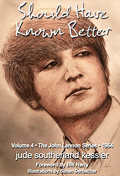


|
|
Glass Onion
Every Little Thing
Dear Sir or Madam...

The John Lennon Series by Jude Southerland Kessler
Hello, Goodbye Comment? Question?
|
|
The White Album The Beatles was released in the UK on November 22, 1968 as Apple PMC 7067-8 (mono) and PCS 7067-8 (stereo) and in the US on November 25, 1968 in stereo as Apple SWBO 101. The White Album was not released in mono in the US. The White Album's original working title was A Doll's House, which is the name of Henrik Ibsen's masterpiece play written in the 19th century. In addition, according to some accounts, an illustration was prepared for the cover of A Doll's House by the famed artist Patrick but the plain white cover was opted for instead. This illustration eventually showed up on Parlophone's The Beatles Ballads in 1980, the Dutch release of which, De Mooiste Songs (The Most Beautiful Songs), is shown below.

Recording sessions for the White Album started with the song Revolution on May 30, 1968, and concluded with take three of Julia on October 13, 1968. Mixing for the album was completed five days later on October 18, 1968. This album marked the first on the then newly formed Apple label, which had made its first appearance as a 45 three months earlier on August 30, 1968 with the Hey Jude/Revolution single, both of which were recorded during the White Album sessions. Also recorded during the White Album sessions were What's the New Mary Jane and Not Guilty. These two tracks were only available on bootlegs for many years, but were finally released legitimately for the first time 28 years after they were recorded on Anthology 3 in 1996. The Guiness Book of Records lists The Beatles as having sold "nearly two million" copies in its first week of release in the US.

Four 8x10 glossies, one of each Beatle, were included as inserts with the White Album. These pictures were taken by photographer John Kelley in the autumn of 1968.
In the United States, one small photograph of Paul and one small drawing of Yoko and John in the poster that was included with the White Album were censored.
 
On the left are scans from a copy of the White Album poster included with a White Album manufactured by EMI in Germany. On the right are unretouched scans of the same places on the poster from a copy made by Capitol in America.
 
Even with the release of the Anthology series, there are still many recordings in the EMI vault that have not been released. Here are some of those which offer us a peek behind the scenes of the making of the White Album.
Over the years some critics have said that the White Album is too self-indulgent, some have said that it's too long and could have easily been one great disc.
This page last enhanced September 1, 2008.
| ||||||||||||
|
|
Search this site
THIS MONOPHONIC MICROGROOVE RECORDING IS PLAYABLE ON MONOPHONIC AND STEREO PHONOGRAPHS.
IT CANNOT BECOME OBSOLETE. IT WILL CONTINUE TO BE A SOURCE OF OUTSTANDING SOUND REPRODUCTION,
PROVIDING THE FINEST MONOPHONIC PERFORMANCE FROM ANY PHONOGRAPH.
Original Content Copyright © 1995-2025 Adam Forrest



